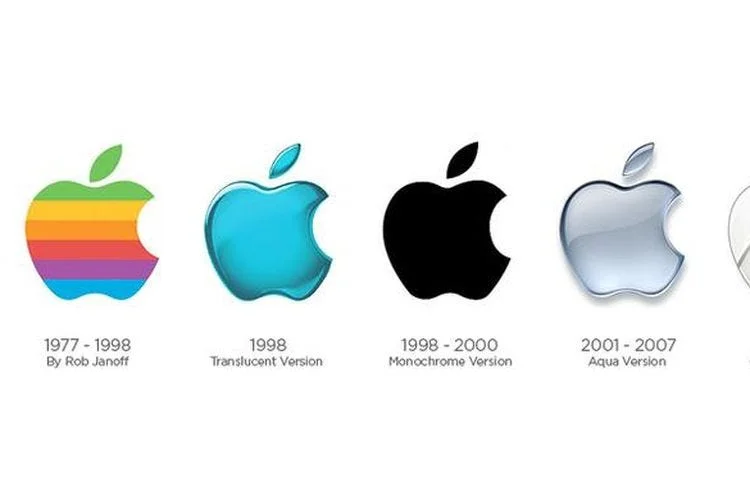Evolution of Apple Logo and Branding: Apple Inc., formerly known as Apple Computer, is one of the most recognizable and influential brands in technology history. Apple has dramatically evolved its logo and branding strategies since its inception in 1976.
This article seeks to provide an overview of the evolution of Apple's logo and branding from the first version, through the Steve Jobs era, to the current iteration.
The initial design of Apple's logo was a rainbow-colored apple with a bite taken out of it, created by graphic designer Rob Janoff. Janoff drew inspiration for this iconic image from both the Biblical story of Adam and Eve as well as engineer Alan Turing's concept of “bitesize computing”.
The name ‘Apple' itself was chosen due to its association with creativity, innovation, and simplicity – values that still remain at the core of the brand today.
READ ALSO: History of Apple Inc.
The Initial Design of the Apple Logo
Apple's iconic logo and branding have become a staple of the modern world. From its inception in 1976, Steve Jobs' creative vision has revolutionized the way that consumers view technology.

The initial design was created by graphic designer Rob Janoff who aimed to capture the spirit of innovation with his groundbreaking creation. Using minimalistic principles, Janoff designed an image consisting of an apple shape with a bite taken out of it – thus creating one of the most recognizable symbols on earth.
The incorporation of color into this already successful logo further helped to solidify Apple's place as a powerhouse in the tech industry. Starting off with just two shades – black and white – Rob Janoff took simple elements to create something timelessly distinctive.
Later versions included full-color palettes which allowed for more flexibility when designing marketing materials or products themselves. This transformed Apple from being driven solely by its devices and software to becoming a lifestyle brand focused on empowering people through its cutting-edge designs and innovative ideas.
With each iteration pushing boundaries and expanding upon what was previously thought possible, Apple's logo is now seen everywhere you look; from billboards to magazines, websites, stores, product packaging…you name it!
It is no wonder then why Apple's visual identity stands as a testament to their dedication to bringing revolutionary concepts to life whilst staying true to their core aesthetic values. As we move forward into 2021, we can expect only greater things from Apple's ever-evolving branding efforts.
With such an eye-catching palette at their disposal, there are endless possibilities ahead for how they will continue to captivate audiences across the globe.
The Apple Color Palette
The introduction of the iconic rainbow-colored Apple logo marked a shift in the company's brand identity, as it was inspired by Stanford University's use of color theory, which had become popular among California's burgeoning tech scene.
This new visual strategy became part of an overall effort to modernize and differentiate Apple from other computer companies during this period.
The bright colors were also reflective of emerging trends within the industry at large, where logos were becoming more visually dynamic and playful compared to their printed counterparts.
As such, the colorful palette chosen for the Apple logo not only served to capture attention but also evoked feelings of optimism, creativity, and energy – values that would soon be associated with the brand's ethos thanks to its ‘Think Different' campaign.
While these vibrant hues gave strength to the design itself, they provided an emotional connection between consumers and the product line that can still be seen today.
Overall, this innovative approach towards branding allowed Apple to stand out from competitors while conveying powerful messaging around their products before launching into one of the most iconic advertising campaigns in history – ‘Think Different'.
With this newfound emphasis on boldness, uniqueness, and creativity, Apple established itself as a revolutionary force within both technology and marketing circles alike.
The “Think Different” Campaign
The ‘Think Different' campaign of 1997 was Apple's first major branding effort, with the introduction of a new slogan and logo.
Ads for the campaign featured a black-and-white portrait of iconic figures, such as John Lennon and Mahatma Gandhi, coupled with the phrase “Think Different.”
The campaign had an immense impact, solidifying Apple's reputation as an innovative and creative company, and helping to launch the brand into the limelight.
It also aligned Apple with a number of other companies and celebrities in the software, entertainment, and media industries.
The campaign was also a major factor in the company's successful transition from a computer firm to a consumer electronics giant.
The ‘Think Different' campaign was a major success that helped to define the Apple brand and shape its future.
Slogan
The ‘Think Different' campaign was one of the most successful marketing campaigns in Apple's history, and it is remembered today as an iconic slogan.
The use of this phrase marks an important shift in Apple's branding strategy from a focus on product features to a commitment to inspiring creativity and promoting brand loyalty among consumers.
Through its memorable phrasing and strong visual imagery, the campaign sought to shape consumer perception by emphasizing individuality over conformity.
This message helped differentiate Apple from other technology companies at the time and laid the foundation for long-term customer relationships that have been integral to their success.
By positioning itself as both innovative and reliable, Apple positioned itself for sustained growth with customers who were seeking quality products and services they could trust.
Ads
The ‘Think Different' campaign was also notable for its innovative use of online advertising and store displays.
Ads ran on television, print media outlets, websites, and even billboards to ensure maximum visibility.
In addition, Apple used an array of unique store display techniques, such as oversized posters featuring famous figures like Albert Einstein and John Lennon.
These marketing tactics helped communicate the message that Apple valued individuality and creativity above all else.
Through these methods, Apple successfully reached a wide audience with their iconic phrase and set out to create brand loyalty among consumers who associated Apple products with innovation and quality.
As a result of this successful branding strategy, Apple has become one of the most recognizable names in technology today.
Impact
The ‘Think Different' campaign had an undeniable impact on the way consumers view Apple as a brand.
By emphasizing innovation and creativity, Apple was able to create a strong emotional connection with its customers.
This connection has remained strong over time, and it is one of the main reasons why Apple continues to be such a powerful force in the technology industry today.
Through social media campaigns, online ads, and retail store displays, Apple was able to capitalize on their messaging by reaching out to people from all walks of life.
The success of this strategy helped solidify Apple's position as a global leader in technology and design.
It also laid the foundation for future branding successes that continue to shape consumer perceptions of how products are used in our everyday lives.
The iPod Silhouette
Can you imagine an Apple product without the iconic white silhouette?
In 2001, this design was first introduced with the release of the iPod. It quickly became a major element in Apple's branding and graphic design that helped to increase brand recognition worldwide.
The iPod Silhouette would become part of all future releases from Apple, including:
- Devices like iPhones and iPads;
- Software such as iTunes;
- Accessories such as cases and sleeves for laptops.
This simple logo has proved itself to be timeless, aiding consumers in recognizing Apple products instantly, no matter their location or language barriers.
Its modernistic yet stylish look contributed to its success, appealing to all generations through its simplicity and familiarity.
Moving forward it is likely that we will see this motif maintained by Apple's creative team across more devices, software, and accessories alike.
As we shift our attention towards iOS icons, there appears to be one constant throughout—the ever-recognizable silhouette of an iPod within each icon.
The iOS Icons
The iPod silhouette was Apple's first branding success, and it set the tone for future generations of product design. After its initial launch in 2001, Apple began to develop a suite of digital products as part of their “iTunes Ecosystem.”
This included the release of new software such as iTunes, iPhoto, iMovie, and GarageBand. As these applications became more popular, Apple shifted its focus to creating user-friendly icons that signified each application within the mobile device market.
This shift towards visual communication saw Apple introducing iconic images which were easily recognizable across different devices and platforms. The iOS icons highlighted Apple's commitment to providing a consistent user experience on all digital products; they served as an identifiable reference point when navigating between apps.
For example, the music note icon represented iTunes while the camera lens symbolized iPhoto — this helped users quickly identify which app they wanted to use without having to read complex instructions or tutorials.
The introduction of iOS icons had a great impact on modern-day digital design principles by emphasizing clarity and simplicity through minimalistic visuals. To achieve this goal, designers employed bright colors and simple shapes which allowed for easy recognition of specific features available within various apps.
By further utilizing white space and vector graphics around each icon, users could quickly find what they needed with greater ease than before – allowing them to take full advantage of the intuitive user experience offered by iOS-powered devices.
The iPad Logo
The iPad logo is like a gateway to an entirely new world of technology. It conveys the innovative design, visual impact, and remarkable capabilities of Apple's tablet computer.
Apple's decision to create a new logo for the iPad was undoubtedly strategic; thus, it had to be crafted with precision and forethought. The original iPad logo featured a silver apple with a glossy edge around it, similar in shape to the iPhone's icon but slightly larger with less beveling along its edges.
This simple yet powerful design embraced modernity while still drawing from the familiar classic look that has become synonymous with Apple products over time.
In addition, the iPad logo features several elements that emphasize its distinctiveness within the Apple family such as:
- Subtle details including small circles on either side of the apple which represent buttons on the device itself
- A bold sans serif font is used throughout, further emphasizing its sleek and modern aesthetic
- An obvious homage to Cupertino's iconic style without being too literal or repetitive
This unique combination makes it instantly recognizable and serves as an effective way to differentiate between different product lines while keeping all devices under one branding umbrella.
Transitioning into discussing ‘the Apple logo today' we can see evidence of this same strategy at play in many aspects of their current designs.
The Apple Logo Today
Apple's logo has gone through many transformations since its inception. The first iteration of the company's branding featured an image of Sir Isaac Newton sitting under a tree, with a quote attributed to him: ‘A mind forever voyaging through strange seas of thought, alone.'

This evolved into an illustration of Sir Isaac Newton in silhouette and then finally into the iconic rainbow-colored apple with a bite out of it. Apple's current logo is a minimalist black representation of this same design.
The evolution of Apple's logo can be seen as an example of how brand loyalty remains strong even when logos change drastically over time. Despite these changes, customers still recognize Apple products due to the strength and longevity of their brand identity which is reflected by the continued use and recognition of the iconic bitten-apple symbol.
Apple remains committed to providing innovative user experiences while also staying true to its core values; this commitment is illustrated in every shift that they have made throughout its history regarding its branding strategy. As such, each transformation represents both progress toward innovation and consistency with established elements that remain important today.
Brand Identity And The Future
Throughout the decades, Apple's logo and branding have evolved to create a strong brand identity in both design and customer loyalty. After the first iteration of the iconic rainbow-hued apple with a bite taken out of it in 1976, there were several modifications made throughout the years that successfully established Apple as an innovative leader in technology.
The company's updated monochromatic look from 1998 was intended to convey simplicity and professional qualities that could easily be identified among its competitors. This modernized version proved to be successful for many years until 2010 when Apple released their latest logo—a simple silver outline of an apple, which still stands today.
Apple has continued to grow exponentially since its inception due largely to its powerful brand identity alongside user experience improvements. The evolution of their logo is just one example of how they continue to honor its roots while propelling forward into the future by staying ahead of trends and providing users with meaningful experiences.
Through this ongoing process, customers remain loyal to what has become one of the most recognizable logos around the world.
READ ALSO: Tesla's Electric Vehicle Technology
Frequently Asked Questions
What Is The Significance Of The Apple Logo Design?
The iconic Apple logo, with its minimalist design and signature half-eaten apple silhouette, has become a timeless representation of the company's innovative spirit and commitment to brand recognition.
Historically speaking, Steve Jobs tasked Rob Janoff in 1977 to create an iconic symbol that would be ‘a reflection of his own personality.'
The result was this revolutionary graphical treat which is now recognized across the globe as one of the most recognizable logos ever created—an enduring testament to Jobs' original vision for Apple.
Its simple design perfectly encapsulated the company's ambition for innovation and proved itself to be a perfect example of how strategic branding can have huge implications for success.
What Is The Financial Impact Of The Apple Brand?
The financial impact of the Apple brand is considerable.
Since its introduction in 1977, the company has worked to create a product that could not only be recognizable but also valued by consumers.
Brand loyalty and marketing strategies such as clever advertising campaigns have gone hand-in-hand with the design of the iconic logo to help create an image of quality and trustworthiness in Apple products.
This powerful combination, coupled with innovative technology, has allowed Apple to become one of the most profitable global brands today.
How Does Apple's Logo And Branding Compare To Other Successful Companies?
Apple's logo and branding have been the subject of much discussion by branding and design historians. In particular, Apple has achieved remarkable success in creating strong brand loyalty with its customer base through various variations of its iconic logo.
This can be seen when compared to other successful companies such as Microsoft or Coca-Cola which also employ multiple iterations of their logos for marketing purposes.
The fact that Apple is able to continually re-invent itself through subtle changes in its logo demonstrates an unparalleled level of corporate communication competence that many brands aspire to achieve.
How Has Apple's Logo And Branding Impacted Consumer Behavior?
Consumer behavior is heavily impacted by brand loyalty, and Apple's iconic logo and branding have been highly influential in this regard.
From the introduction of its first rainbow-colored apple to its modern monochrome design, each iteration has served as a reminder of Apple's commitment to quality innovation.
Studies have shown that consumers respond positively to visual cues associated with successful companies. As such, the consistent use of Apple's logo and branding over time has helped reinforce consumer trust in their products while also creating an emotional connection between customers and the company itself.
How Has The Apple Logo And Branding Evolved Over Time?
The Apple logo and branding strategies have evolved over time in order to keep up with the changing marketing landscape.
Many of these changes can be traced back over four decades, beginning with the first official Apple logo designed by Ronald Wayne in 1976.
This design featured a simple apple silhouette filled with rainbow stripes that symbolized both the company's hardware capabilities and its innovative spirit.
Since then, subsequent logos have been redesigned to include more modern elements such as gradient colors and 3D effects while still maintaining the same iconic imagery of an apple shape, illustrating how even subtle updates can make a major impact on brand recognition.
As technology continues to evolve, so too will Apple's logo and branding strategies, allowing them to remain at the forefront of their industry for years to come.
Conclusion
The Apple logo is one of the most recognizable symbols in the world. Its design has become an icon, representing innovation and creativity throughout its evolution. Over time it has come to represent not only a technological company but also a lifestyle brand that appeals to people across demographics and cultures.
Various studies have shown that Apple products are associated with high quality, trustworthiness, and reliability—a testament to how powerful their branding strategy is. The financial impact of this strategy is undeniable; Apple's brand value was estimated at $182 billion by Interbrand in 2020.
By understanding how Apple's logo and branding evolved over time, we can gain valuable insights into successful methods for designing logos and creating identities for businesses today.
Thank you for reading our article today! Please remember to share this article on social media to help others benefit too. It also helps us improve our algorithm and relevance to the public. Thanks for Sharring!!! Follow us on Socials: Facebook - LinkedIn - Twitter








